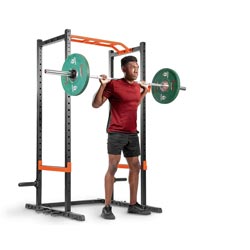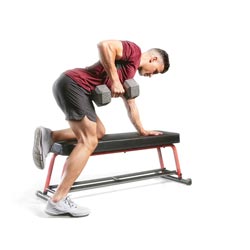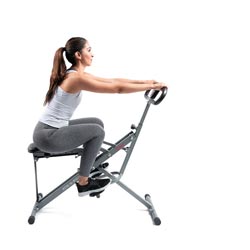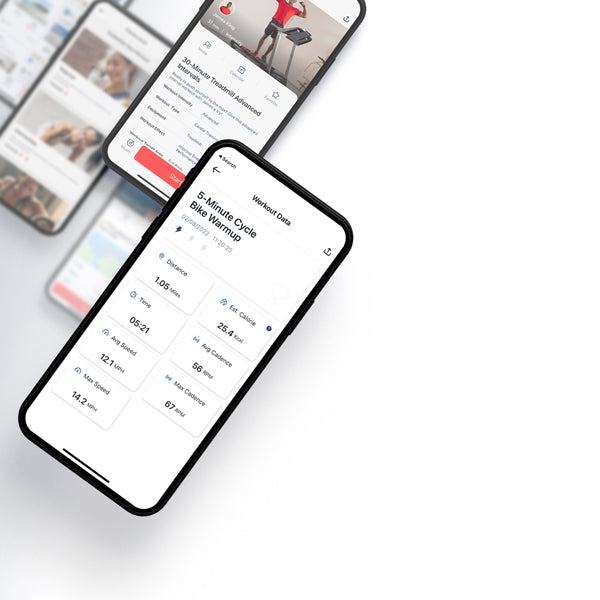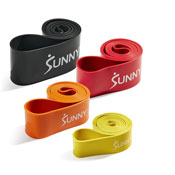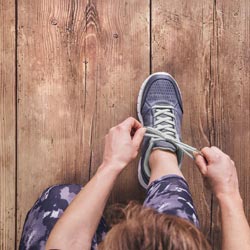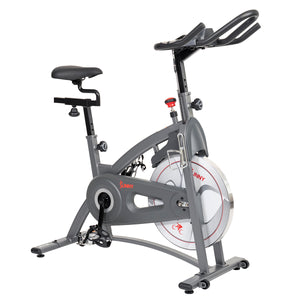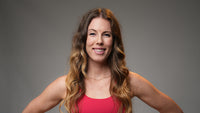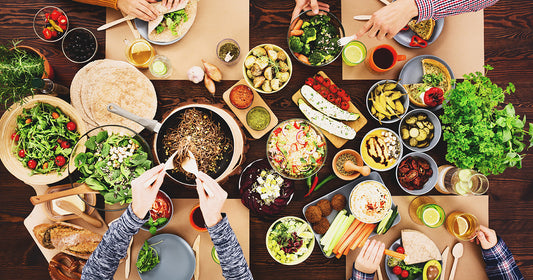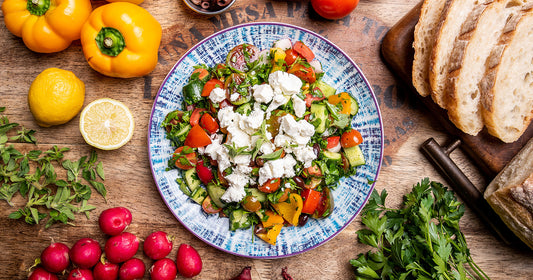Raise your hand if you’ve been putting in work at the gym and have yet to see a return for your efforts. Understandable.
You’ve likely noticed some changes like having more energy, or gaining confidence; but, if you’re after targeted results—like weight loss or muscle gain—it may require a more targeted approach.
It’s not just your workouts that matter. Sure, your workout program is important (if you’re looking for scientifically designed programs from world-class trainers this is my shameless plug for the SunnyFit® app), but your diet plays a huge role in the physical changes you see from said program.
Dialing in on nutrition is empowering. It helps you punch in on how your food impacts your fitness results and gives you the insight to tweak your plates for exact fitness results.
Below, you’ll learn what a balanced diet is, what foods to eat and foods to avoid, and how to tailor your calorie intake and macros for your goals.
What Is a Balanced Diet?
A balanced diet delivers the nutrients your body needs to function properly. At the highest level, you need to ensure you’re eating enough calories to fuel your body for exercise and life. “If you’re not eating enough or not getting the proper nutrition it’s like putting regular gas in a diesel engine.” says Sunny trainer Alexa Lambarri.
What those calories are made up of is also critical to how you feel, and how your body adapts to your exercise routine. Your diet should include a balance of the three major macronutrients: proteins, carbs, and fats, as well as essential micronutrients: vitamins and minerals.
These nutrients give your body everything it needs for peak performance. Functions like delivering oxygen to your muscles, making ATP for energy, and repairing muscles after a challenging workout.
Why a Balanced Diet Is Important
People who say calories are all that matter are misinformed. Of course, calories are important. But a diet that fails to provide a balanced blend of nutrients is like a car missing a wheel or two. To run smoothly, a car needs all four wheels. Just like a car, you need a balance of food to operate as intended.
By fueling your body with a good balance of macronutrients and micronutrients you’re able to sustain optimal health. Without a balanced diet, your body is more prone to disease, infection, fatigue, illness, and low performance.
A balanced diet is essential to your body operating at the lowest degree. Even people who don’t exercise need a balanced diet to fuel their daily functions like sitting at a desk, walking to the mailbox, and cooking dinner.
When you add exercise into the equation, it’s a whole new ball game. Exercise requires your body to operate at a higher level, which is when solid nutrition becomes even more important.
How a Balanced Diet Impacts Your Workout Results
The way you decide to balance your diet depends on your goal. For example, a balanced diet for someone who wants to gain muscle can look very different from someone who wants to lose weight; however, there are some common factors at play.
Adjusting Your Calories to Your Workout Goals
The calorie breakdown is the simplest way for people to grasp. “If you want to lose weight you need to be in a caloric deficit,” says Sunny trainer Luis Cervantes. A caloric deficit is when you eat fewer calories than you burn, so your body burns stored nutrients (like fat) for fuel.
“If you want to gain muscle you need to be in a calorie surplus,” says Luis. “Surplus means you want to eat more calories than you’re burning in order to keep that weight on.” Without enough fuel, it’s impossible for your body to repair and adapt to your workout—the key to building muscle mass.
Adjusting Your Macros to Your Workout Goals
But as previously mentioned, the content of those calories matters, too. Luis breaks it down. “I like to think of it like a pie. You have your thirds: your proteins, fats, and carbs. The way you ration it depends on your goal,” he says. “If you’re looking to put on muscle, you might throw in little extra carbs and protein, so those thirds might get a little bigger. If you’re trying to lose weight you might eat a little more protein and fewer carbs.”
Macros aren’t an exact science which is what can make adjusting them tricky. The secret is to start with a baseline and track how many calories are coming from each of the three categories. Everyone’s body responds differently. It’s your job to stay mindful, tune into how your body responds and adjust as needed.
Foods to Eat as Part of a Balanced Diet
ICYMI, the foods you put into your body matter. The question is: what to eat? Below is a list of nutrients and foods to prioritize throughout the day.
Healthy Fats
Fat truly gets the short end of the stick. Whether you want to lose weight, gain muscle, or simply maintain the word ‘fat’ doesn’t sound like a good thing to put in your body. Plot twist: it is.
Fat helps give your body energy, protects your organs, supports cell growth (including muscle growth and repair), helps keep your cholesterol and blood pressure under control, and helps your body absorb the fat-soluble vitamins A, D, E, and K.
To get more of it, eat more of these foods:
- Nuts
- Seeds
- Legumes
- Avocado
- Eggs
- Fish
- Yogurt
Luis loves yogurt as a source of healthy fat because it packs a high amount of probiotics which help promote a healthy gut. If you’re new to eating clean, the fiber in whole grains, fruits, or vegetables can be a shock to your digestive system. Yogurt can make that adjustment a bit easier. Luis warns to check the food label. Look for an option that maximizes whole ingredients, and cuts back on added sugar.
Healthy Carbs
Carbs also have a bad reputation. Over the years, people have villainized carbs, blaming them for weight gain. This might be true when it comes to highly processed carbs like baked goods, boxed crackers and cookies, and refined white bread.
Healthy carbs, on the other hand, are your body's main source of energy. They also help your muscles repair after a hard workout, and help you feel full and satisfied throughout the day (which can help you comfortably maintain the caloric deficit necessary to lose weight). Carbs are an important tool in any fitness journey.
To get more carbs, prioritize these high-quality sources:
- Fruits
- Vegetables
- Leafy Greens
- Quinoa
- Brown Rice
- Buckwheat
- Bulgur
- Barley
- Oats
- Whole Wheat Bread, Pasta, or Crackers
For his source of carbs, Luis loves a serving of whole grains. “A lot of the whole grains that you will find are also a sneaky source of protein, which makes it a win-win,” he says. Be sure to include a blend of whole grains, fruits, and vegetables as a part of your meal. Fruits and veggies are packed with essential micronutrients.
Healthy Proteins
Protein is essential. It can help speed recovery after exercise or injury, reduce muscle loss, build lean muscle, help maintain a healthy weight, and curb hunger. While your ratio of fat and carbs may fluctuate from day to day, Alexa notes getting at least .8 grams of protein per kilogram of body weight per day is a must.
Opt for lean proteins most of the time. For example:
- Chicken
- Turkey
- Fish
- Seitan
- Tofu
- Chia Seeds
- Hemp Seeds
- Beans
- Edamame
Opting for lean protein will help you reduce saturated fat in your diet, which has been linked to heart disease (1). That doesn’t mean you can’t enjoy fattier cuts of meat like steak from time to time. In fact, beef is an incredible source of iron, vitamin B12, and creatine—harder to get micronutrients that have a direct impact on how you feel and perform day to day.
Fish isn’t always considered lean either. However, Luis notes the fat in fish is beneficial: “Some fish can have a little more fat, which isn’t a bad thing because it’s healthy fat.” Fatty fish like salmon and tuna are packed with omega 3’s which can improve heart health.
Foods to Avoid as Part of a Balanced Diet
The first step to eating a balanced diet is focusing on what healthy foods you can add to your daily meals and snacks. But at some point, indulging in unhealthy food cravings too often could make the difference between reaching your goals and not. You’ll know when it’s time for a reality check.
Here are the foods to minimize in a healthy balanced diet:
- Processed foods (boxed crackers, cookies, frozen meals)
- Refined Grains (white bread, pasta)
- Added sugar and salt
- Processed meat (like bacon, salami, and hot dogs)
- Alcohol
It’s important to note, all foods (even those above) have their place in a balanced diet. It’s how often you incorporate them into your diet that counts. Sunny Trainer James King III recommends a balance of 80% healthy, whole foods, and 20% cheat meals.
How Long Does It Take to See Results?
In general, it takes about six to eight weeks to notice physical changes in cardiovascular health, endurance, strength, and appearance from diet or exercise. Stay steadfast and you will see results.


